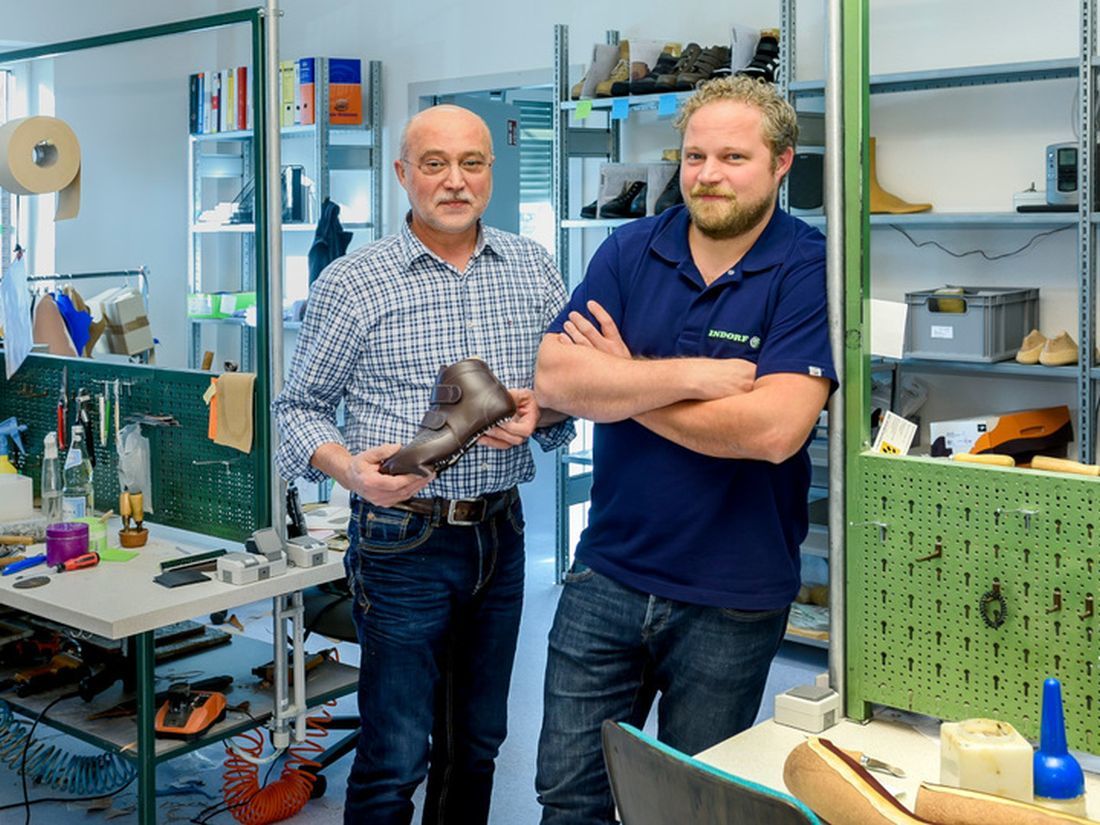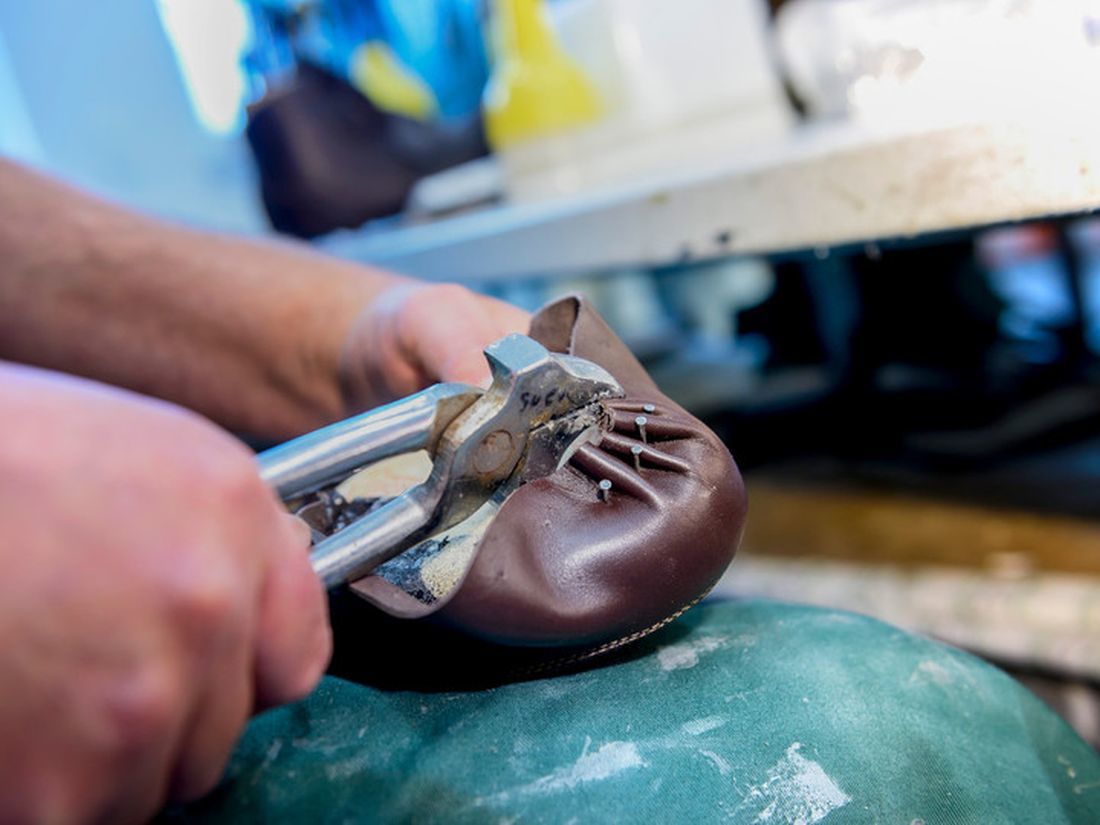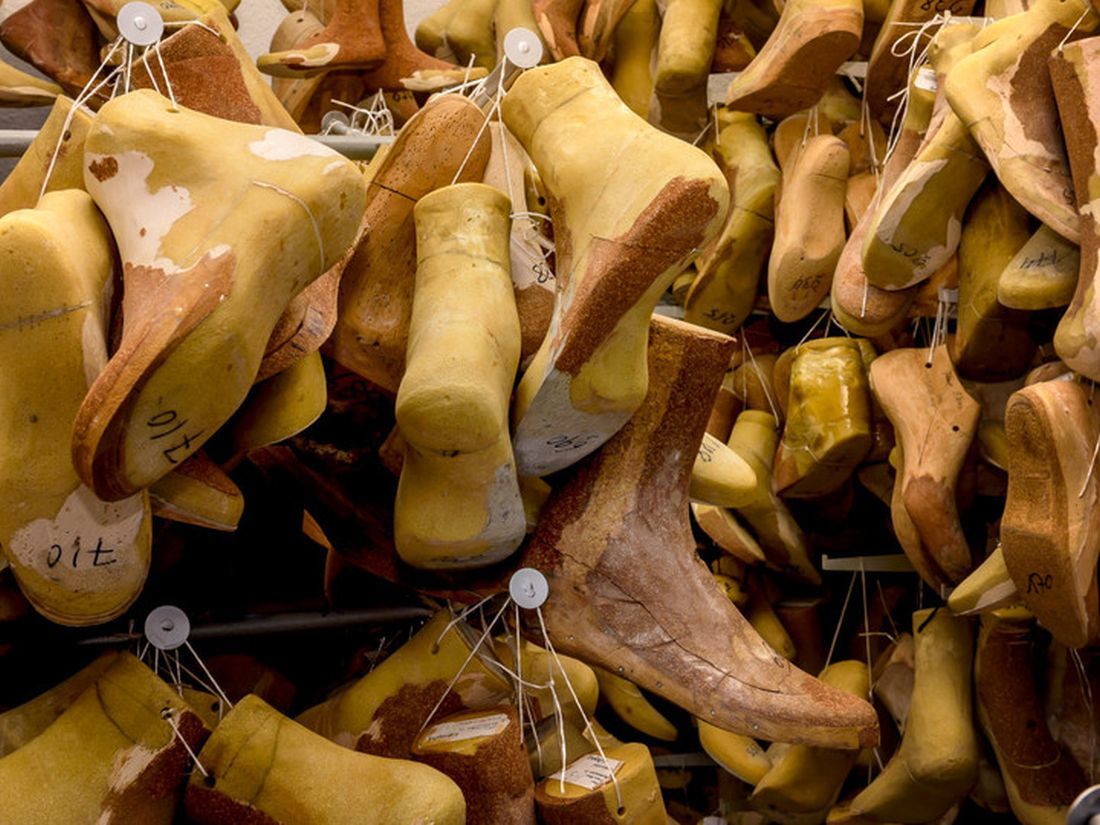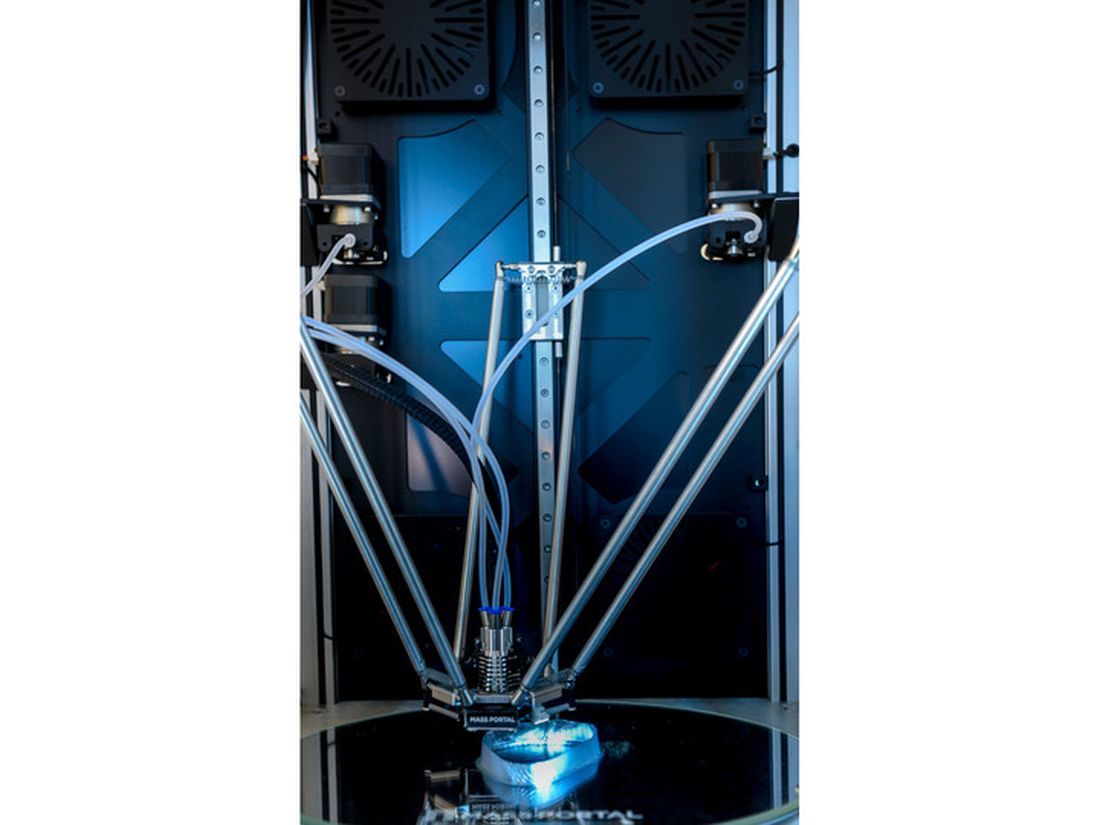A successful future based on attention to detail
Success stories
What would be your idea of a traditional manufacturing company in the orthopaedic shoe sector? You might be picturing a small workshop with traditional tools on the workbench, a sewing machine, a device for grinding and polishing, with scraps of material scattered around the working platform and a pervasive smell of leather, rubber and glue. But Indorf Orthopädie-Schuhtechnik GmbH & Co. KG in Bremerhaven quickly exposes any such notions as lazy clichés. Rolf Indorf and his son Tim have set a course for growth and future success with a new building, new services, and new, ergonomic production methods.
On 8 June 2018, the two orthopaedic master shoemakers celebrated the opening of their new premises at Rudloffstrasse 64 together with their ten employees and a number of guests. The building offers around 450 square metres of floorspace, with a reception area, workshops, store rooms, offices and staff areas. “This new building is helping us make the company fit for the next 81 years,” says Tim Indorf, in reference to the origins of the company, which was founded in Bremerhaven in 1937. Indorf acquired the municipal site, which covers just over 1,700 square metres, for its new building with the help of BIS Bremerhavener Gesellschaft für Investitionsförderung und Stadtentwicklung mbH. Together with BAB – the development bank for Bremen and Bremerhaven – BIS was also able to further support the investment project by accessing subsidies from the LIP 2014 regional investment programme. “Bremeninvest, the BAB and Weser-Elbe Sparkasse savings bank all supported us greatly with help and advice. The whole thing was seamless,” reports Tim Indorf approvingly as he looks back on the collaborative efforts of all those involved. Indorf supplies and makes orthopaedic shoes, offers adaptation of mass-produced shoes (incl. safety shoes) and insoles, and also provides shoe repairs. The range of products and services has been carefully planned and is clearly defined. “Our advantage is that we do not need to maintain an online shop. Our products are handmade, but we do not offer traditional bespoke shoemaking either. With our shoes, there is always an orthopaedic element involved. However, we do supply a lot of sportspeople with suitable shoes,” says Tim Indorf as he explains the company’s philosophy.

The business has expanded rapidly over the last few years thanks to comprehensive customer support that includes services such as individual requirement analyses, electronic analyses of pressure and gait and various other measures, coupled with the entry of Tim Indorf into the family business. Eurogate, Lloyd’s shipyard, Tchibo, NTB, BLG, Frozen Fish (Iglo), Senvion and others – the list of customers quickly grew longer and longer.
The list of customers quickly grew longer and longer.
Orthopaedic master shoemaker Tim Indorf
“I joined the company in 2008 as a journeyman and became a master craftsman in 2013. From that point on the firm had two orthopaedic master shoemakers, so we could take on additional orders. My father continues to be a fully active part of the operation. This allowed us to expand our portfolio, and we have acquired many new customers,” explains Tim Indorf as he describes developments over the past few years which ultimately led to the decision to invest in a new company building.
When Indorf is not in the office, where the telephones seem to be constantly demanding his attention, he’s on the road. He estimates that around 90 per cent of his time is not spent in the office or the workshop, but on site with his customers where he provides consultations on aspects such as work and safety shoes, individual foot measurements, and product development. This may require workplace inspections or dynamic pressure measurements on customers’ feet. Then there are individual gait analyses, and the assessment of safety categories required for footwear in tough working environments. And ergonomics and comfort always have a role to play as well, of course.
‘Can’t be done’ just doesn’t cut it
The shoes are normally supplied by partners, based on the specifications from the orthopaedic analyses. For major customers such as Eurogate, who require several tens of thousands of pairs a year, this can take the form of direct distribution. For customers whose orders are on a more manageable scale, Indorf supply the shoes themselves or put them in touch with suitable suppliers. If existing models of shoes simply will not fit, Indorf is able to offer adaptations, insoles or made-to-measure footwear. ‘Can’t be done’ just doesn’t cut it. The company’s new building contains state-of-the-art machinery that can be adjusted to each employee’s individual working height at the push of a button. Elaborate extraction systems and filters provide clean air for the workshops. The workbenches have different working heights. The equipment for the orthopaedic adaptation of the shoes is fitted with hydraulic ramps – which benefits customers (wheelchair users) as well as employees. And there is a 3D printer that transforms the data recorded by the foot scanners and foot cameras into perfectly fitting lasts for custom-made shoes.

Indorf’s stock of old lasts gives a glimpse into the traditional production process before 3D printers, which is occasionally still used today. At one time, an orthopaedic specialist used to measure the customer’s feet and then create lasts to produce specific shoes based on these measurements from a block of beechwood. A more recent technique for producing lasts which is still in use is to take a plaster cast of the foot and then fill it with plastic foam. Around 1,000 such lasts – stored in numerical order at an easily accessible height – provide Indorf with a valuable base for subsequent orders.

It isn’t any quicker to produce the model of the foot using a 3D scanner, CAD software and a printer rather than a plaster cast, explains Tim Indorf. The main advantage is that the scanner, which is the shape and size of a vacuum cleaner nozzle, can be used anywhere, including on the customer’s premises. There is also no need for the cover sheets and cleaning buckets required for the production of plaster casts. After a short pan around the customer’s feet the hand scanner delivers precise results that can be easily replicated.
The fifth customer worldwide ...
Using CAD software and 3D printers does take a bit of practice. Indorf is certainly an industry pioneer. The new equipment is produced by the company go-tec, based in Münster, Westphalia. Indorf says they were go-tec’s fifth customer worldwide. As an early adopter of a new technology, they don’t have access to the support of a large user community but must rely on trial and error instead. Indorf admits that there is still room for improvement when it comes to consistent output quality and dimensional accuracy of the results, and for now they are aiming for progress with individual projects. But two machines are already in place, with a third one to follow soon. “I knew that we would not simply be able to get cracking right away. But I want to be one of the people who are ready to go immediately when the time comes. Anyway, the technology will only make economic sense when the machines are operating around the clock.” There is also another reason to be planning for the future now. Like many other industries, suppliers of orthopaedic shoe technology face considerable problems in recruiting qualified employees. The Indorfs know this means they will need to find solutions to simplify and support the work processes in future.
Employees are actively involved in the planning
The challenges of new technologies and processes require a certain degree of openness and flexibility. This was true at Indorf when they were planning the workshops, offices and staff areas at the new site in Rudloffstrasse 64. Father and son sketched out their early designs on A1 sheets of paper and asked their employees for feedback and suggestions for improvements. According to the Indorfs, this led to a substantial number of changes to the details. There was also discussion about a fairly recently added electric repair machine in the sewing room, which now sits abandoned in a corner to the left of the entrance. It has been ‘banished’ there because the workforce unanimously decided to keep working on the historical foot-powered Adler sewing machine rather than use the newer one. It allows them to apply a more delicate touch, and will continue to be used and maintained with the utmost respect.
A running track around the company building
Next year the Indorfs are planning to install a running track with stone and tarmac sections around their new building in Rudloffstrasse. This would enable customers to take their new orthopaedic shoes or insoles for a trial run. With such attention to detail, the Indorfs are gearing up for a successful future.
Success Stories
8 Bremen Companies involved in Mass Spectrometry
If you want to get down to the smallest building blocks of our world, you need mass spectrometers. And there are few places in the world where there is such a high concentration of specialists and manufacturing companies and suppliers in this sector as in Bremen.
Learn moreNine products from Bremen that nobody has heard of, but everyone uses
Products made in Bremen can be found in many everyday objects, and most of us are likely to come into contact with one or more on a daily basis. Read on to find out what they are.
Learn moreClockwise opens its first German location in Bremen: Flexible coworking with a regional flair
The British company Clockwise has opened its first German location in Bremen. With locations in London, Belgium, The Netherlands, and now on Martinistraße in the city center, the company follows a clear vision: to create workspaces that are flexible, welcoming, and tailored to the needs of modern professionals.
Learn more
